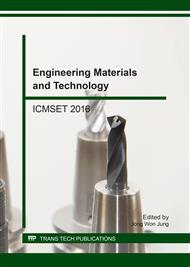p.184
p.192
p.198
p.209
p.214
p.220
p.225
p.231
p.236
Residual Stress/Strain Effect on the Bending Properties of the Cu/Al/Cu Clad Plate
Abstract:
One of the important issue in the production of the industrial scale Cu/Al/Cu clad plate is the evolution of residual stress/strain during rolling the stack of thick slabs into thin wide and long plates. In this study, the effect of residual stress/strain and annealing on the bend forming behaviors of Cu/Al/Cu clad composite were studied. Tensile strength of separated convex side Cu layer from the bent Cu/Al/Cu clad plate was observed 350MPa, smaller than that of concave side Cu-layer (380MPa). The lower strength and higher fracture strain in the convex side Cu layer is attributed to the presence of the compressive residual strain in the convex side. After heat-treatment at 380°C no pronounced interface debonding and separation between Cu and Al layers were noted, supporting a reliable interface bonding between Cu and Al. The ductility of Cu/Al/Cu clad plate was observed to be greater than that of Al, which can be explained by the co-deformation induced the interaction and constraint between bonded Al and Cu layers. The bend forming behavior of the bent Cu-Al-Cu clad composite was not greatly influenced by the residual stress/strain developed during rolling because of the thick Al layers with negligible residual stress between Cu.
Info:
Periodical:
Pages:
214-219
Citation:
Online since:
June 2017
Authors:
Keywords:
Price:
Сopyright:
© 2017 Trans Tech Publications Ltd. All Rights Reserved
Share:
Citation:


